FINDING AREA AND PERIMETER OF REGULAR POLYGONS
What is polygon ?
A polygon can be defined as a flat or plane, two-dimensional closed shape with straight sides. It does not have curved sides.
Regular polygon :
A polygon having equal sides and equal angles is a regular polygon.
To find area of regular polygon, we use the formula
What is Apothem ?
A line from the center of a regular polygon at right angles to any of its sides.
Find the perimeter area of each regular polygon. Leave your answer in simplest form.
Example 1 :
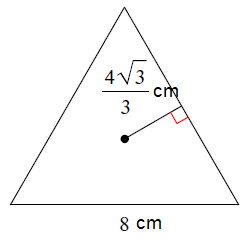
Solution :
The given triangle must be a equilateral triangle, because it is regular polygon.
Perimeter of equilateral triangle = 3 x side
= 3(8)
Perimeter = 24 cm
Example 2 :
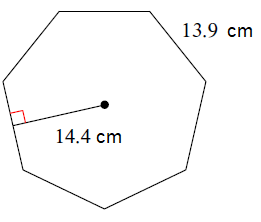
Solution :
Number of sides = 7
Perimeter of the shape = 7 x 13.9
= 97.3
Perimeter = 97.3 cm
Length of apothem = 14.4 cm
Example 3 :
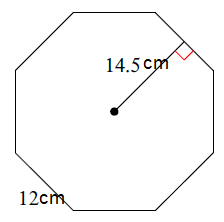
Solution :
Number of sides = 8
Perimeter of the shape = 8 x 12
= 96 cm
Perimeter = 96 cm
Length of apothem = 14.5 cm
Example 4 :
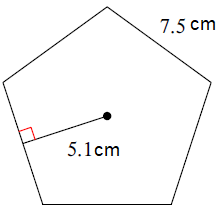
Solution :
Number of sides = 5
Perimeter of the shape = 5 x 7.5
= 37.5 cm
Perimeter = 37.5 cm
Length of apothem = 5.1 cm
Example 5 :
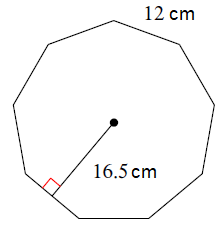
Solution :
Number of sides = 9
Perimeter of the shape = 9 x 12
= 108 cm
Perimeter = 108 cm
Length of apothem = 16.5 cm
Example 6 :

Solution :
Number of sides = 6
Perimeter of the shape = 6 x 10
= 60 cm
Perimeter = 60 cm
Length of apothem = 5√3 cm
Example 7 :
You are decorating the top of a table by covering it with small ceramic tiles. The tabletop is a regular octagon with 15-inch sides and a radius of about 19.6 inches. What is the area you are covering?
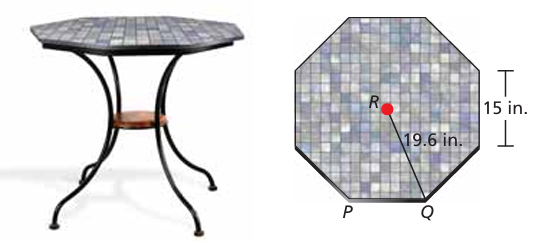
Solution :
Step 1 :
Find the perimeter P of the tabletop. An octagon has 8 sides,
so, P = 8(15) = 120 inches.
Step 2 :
Find the apothem a.
The apothem is height RS of △PQR. Because △PQR is isosceles, altitude RS bisects QP.
So, QS = (1/2) (QP) = (1/2) (15) = 7.5 inches.
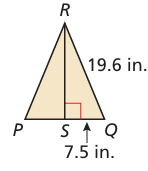
To fi nd RS, use the Pythagorean Theorem (Theorem 9.1) for △RQS.
a = RS = √19.62 − 7.52
= √327.91
≈ 18.108
Step 3 :
Find the area A of the tabletop.
A = (1/2) aP
= (1/2) (√327.91 ) (120)
≈ 1086.5
The area you are covering with tiles is about 1086.5 square inches.
Example 8 :
Use the diagram.
a) Identify the center of polygon JKLMN.
b) Identify a central angle of polygon JKLMN.
c) What is the radius of polygon JKLMN?
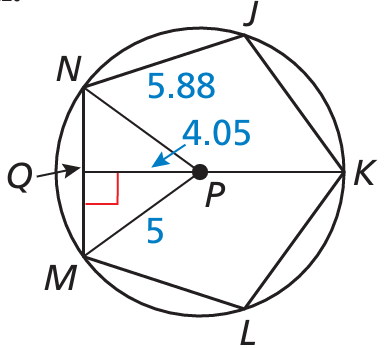
Solution :
a) NM = 5.88
QN = (1/2) NM
= (1/2) x 5.88
= 2.94
b) The centeral angle = 360
= (1/5) of 360
= 72
= 360 - 72
c) Radius = 5
Example 9 :
Find the area of the shaded region.
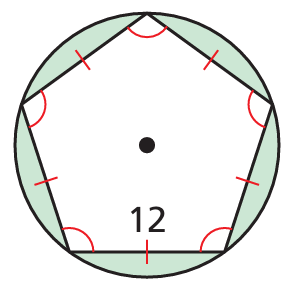
Solution :
Area of shaded region = area of circle - area of pentagon
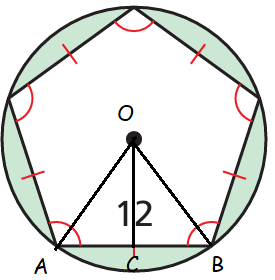
Angle created by the triangle with center = 360/5
= 72
Considering the triangle OCB,
<OCB = 90, <CBO = 36 and <COB = 36
BC = CO = 6
Area of pentagon = (1/2) x perimeter x apothem
= (1/2) x 5(12) x 6
= (1/2) x 60 x 6
= 180 square units
Using Pythagorean theorm in triangle OCB :
OB2 = OC2 + BC2
OB2 = 62 + 62
= 36 + 36
= 72
OB = √72
= 8.48
Area of shaded region = πr2 - 180
= 3.14 (√72)2 - 180
= 226.08 - 180
= 46.08 square units
Example 10 :
The perimeter of a regular nonagon, or 9-gon, is 18 inches. Is this enough information to find the area? If so, find the area and explain your reasoning. If not, explain why not.
Solution :
Perimeter of regular polygon = 18 inches
Let a be the side length of nanogon
Number of sides of a nanogon = 9
9a = 18
a = 2 inches
To find area of polygon, we will use the formula 1/2 x perimeter x apothem.
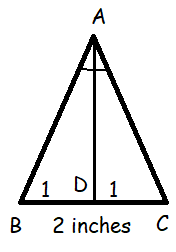
<BAC = 360/9
= 40 degree
<DAC = 20 degree
<BCA = 40
tan 40 = AD/DC
0.839 = AD/1
AD = 0.839
Area of nanogon = (1/2) x AD x 18
= (1/2) x 0.839 x 18
= 9 x 0.839
= 7.551 square inches
Recent Articles
-
Finding Range of Values Inequality Problems
May 21, 24 08:51 PM
Finding Range of Values Inequality Problems -
Solving Two Step Inequality Word Problems
May 21, 24 08:51 AM
Solving Two Step Inequality Word Problems -
Exponential Function Context and Data Modeling
May 20, 24 10:45 PM
Exponential Function Context and Data Modeling